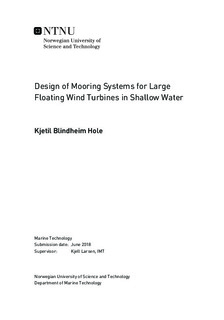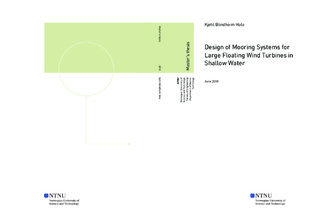| dc.description.abstract | Hywind Scotland is the first operational floating wind turbine park in existence. It was developed
by Equinor and is located off the coast of Scotland at a water depth of approximately 105m.
In this thesis, a time domain model of a semi-submersible floating wind turbine is used to check
the feasibility of floating wind turbines placed at 70m water depth. If this is proven feasible, new
areas for floating wind turbine parks will become available for development.
This thesis describes relevant literature for mooring systems, and preexisting offshore wind turbine
concepts. Rules and regulations for floating wind turbines are described with respect to
ULS, ALS and line slack.
The environmental conditions for this thesis are empirical data from the cite of Hywind Scotland,
given by a metocan design basis from Equinor. The design requirements for floating wind
turbines states that it needs to be able to withstand a storm with a 50-year return period, and
current with a 10-year return period.
The time domain model is created in SIMO-RIFLEX using SIMA, and is a simplification of a preexisting
model crated by Qiang Wang. The aim of the simplification is to create a model with reduced
simulation time which is able to efficiently and accurately perform mooring analyses for
different systems. This was achieved by removing structures representing the wind turbine, and
modeling the semi-submersible floater to behave as a full turbine. By comparing the simplified
model with the original model, it is shown that the excited motions are similar, the simplified
model uses 64% of the original simulation time.
To provide feasible mooring systems for a wind turbine in shallow water, chain mooring systems
following the catenary equations and taut mooring systems compiled of polyester ropes
are analyzed. It is found that for a water depth of 70m a full chain system is not feasible, and a
significant reduction in axial stiffness is needed to meet the requirements for ULS. The simulations
shows that a taut mooring system with 800m lines is feasible. Shorter lines can withstand
ULS, but the dimensioning factor is slack, and longer lines are required. | |

